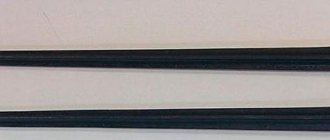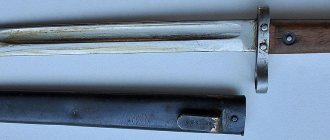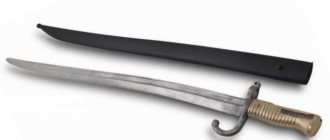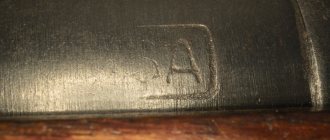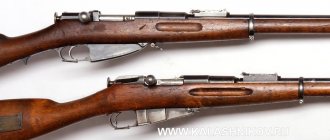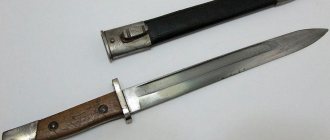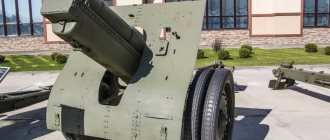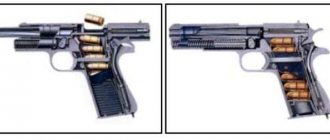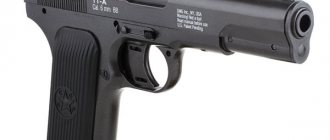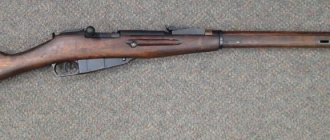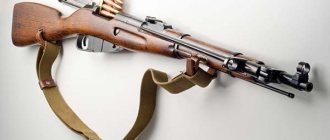The history of the tetrahedral bayonet for the Mosin rifle
The history of the needle tetrahedral bayonet dates back to 1870, when the bayonet was developed for the 1870 Berdan rifle. Already in 1891, this model of bayonet was adopted by the Russian army together with the Mosin rifle. At that time it was considered one of the most dangerous and terrible types of melee weapons. The tetrahedral needle blade was almost half a meter long and inflicted very deep and penetrating wounds, which subsequently led to severe damage to a person’s internal organs. At the same time, the existing small entrance hole did not make it possible to immediately assess on the spot the degree of damage and the depth of penetration of the weapon into the body. All this led to internal bleeding and various infections, which, as a rule, led to peritonitis and, in most cases, death.
An interesting fact is that in the armies of Western Europe the bayonet was considered a weapon of last chance; it was practically not used there and such a thing as a bayonet attack, one might say, did not exist there. Thus, the attachment on the barrel of a musket, which led to the death of the enemy, was used only when the need for self-defense and defense arose. At that time in Russia, in particular in the Soviet Union, the deadly bayonet charge became a real legend. It is not without reason that the great Russian commander Alexander Vasilyevich Suvorov introduced it as a cult, while relegating bullet shooting fired from firearms to the background. Surely, every Russian who is even the least interested in the history of his homeland knows his catchphrase, which says: “The bullet is a fool, but the bayonet is a good man.”
Bayonets for the Mosin rifle lasted almost fifty years, the peak of their popularity came during the revolution and the Civil War. In addition, this bayonet killed a huge number of Nazis on the battlefield during the Great Patriotic War; this type of weapon became a symbol of victory against the Nazi invaders. Soon there was talk of replacing the needle tetrahedral bayonet with bladed bayonets for repeating rifles, but this decision was never made in order to save money. The disadvantages of using a bayonet began to be expressed more and more clearly in conditions of trench warfare, since in a cramped trench a rifle with a bayonet was only a burden and caused a lot of inconvenience. In addition, the bayonet tended to break very often at the most inopportune moments.
Already in the twentieth century, bayonet battles had practically become obsolete, and were quite a rare occurrence; therefore, wearing a bayonet on a weapon became inappropriate. Now the first thing they began to pay attention to was the convenience of the weapon itself, but much less attention was paid to its properties. In 1916, acute problems related to the production of weapons arose throughout the planet, in particular in all warring countries. It is worth noting that in all these countries, combat experience clearly showed that the role of the bayonet in modern combat has dropped significantly, thus the bayonet became unnecessary and, in addition, began to cause a lot of inconvenience. Based on these conclusions, new models began to be produced in Austria-Hungary and Germany, the so-called ersatz bayonets, which were made using very simple technologies and from low-grade steel.
But unlike their predecessors, these new models were much cheaper and more technologically advanced. Russia also began to mass-produce bayonets of the 1916 model; now the bayonet began to provide the ability to inflict circular and slashing blows on the enemy, and when the reverse stroke was carried out, then hit with the side surface of the butt. Accordingly, the piercing properties of the old needle tetrahedral bayonet came to naught. But the advantage of the new weapon was that it was much cheaper and easier to produce, which was extremely necessary in that difficult and difficult time.
If we talk about the dimensions of the very first bayonet of the 1891 model, they were as follows:
- the total length of the weapon was 500 mm;
- blade length 430 mm;
- blade width 17.7 mm.
Mosin rifle model 1891 1891-10 1891-30 carbine model 1938 and 1944 (Russia - USSR)
Original rifles of the 1891 model. The Cossack rifle looked similar to the Dragoon rifle.
Mosin infantry rifle model 1891-1910.
Mosin rifle model 1891-1930.
Model 1938 carbine.
Model 1944 carbine. The bayonet is folded.
Sniper rifle model 1891-30.
View of the receiver and bolt of a rifle model 1891-30 (pre-war production - the receiver in the front part has an octagonal cross-section; wartime rifles had round receivers).
Standard needle bayonet of the Mosin rifle, model 1891.
Cartridges for the Mosin rifle caliber 7.62×54mm R. on the left - a loaded clip on the right, from top to bottom: a cartridge of the 1891 model with a blunt bullet and two cartridges of the 1908 model with a pointed bullet and lacquered steel and brass sleeves, respectively.
| infantry rifle model 1891 and 1891/10 | dragoon rifle model 1891 and 1891/10 | rifle model 1891/30 | carbine model 1938 | carbine model 1944 | |
| Caliber | 7.62×54mm R | ||||
| Type | manual reloading, longitudinally sliding rotary bolt | ||||
| Length | 1306 mm 1738 mm with bayonet | 1234 mm 1666 mm with bayonet | 1234 mm 1666 mm with bayonet | 1020 mm | 1020 mm |
| Barrel length | 800 mm | 730 mm | 730 mm | 510 mm | 510 mm |
| Weight | 4.22 kg 4.6 kg with bayonet | 3.9 kg 4.28 kg with bayonet | 3.8 kg 4.18 kg with bayonet | 3.45 kg | ~3.9 kg with permanent folding bayonet |
| Shop | 5 rounds in a permanent box magazine, equipment from clips | ||||
With the development of weapons and general technologies at the end of the 19th century, a new, qualitative leap in the development of long-barreled individual weapons was outlined in small arms - the emergence of smokeless powders ensured the transition to reduced calibers, and in combination with the development of technology - also the creation of acceptable magazine-fed systems for replacement single-charge systems. In the Russian Empire, relevant research began back in 1883, for which a special commission was created at the Main Artillery Directorate of the General Staff. As a result of lengthy tests, by 1890, two systems of magazine rifles reached the finals - a domestic one, developed by Captain S.I. Mosin, and Belgian, developed by Leon Nagan. Based on the test results in 1891, a rifle was adopted for service, which was more or less the basic design of Mosin with some (not too significant, but nevertheless available) borrowings from the Nagant system. In particular, according to some reports, the design of the magazine feeder and plate clip were borrowed from Nagan. The rifle was adopted for service under the designation “3-line rifle model 1891.” 3 lines in the old Russian system of measures are equal to 0.3 inches, or 7.62mm. Along with the rifle, a new three-line (7.62mm) cartridge was adopted, now known as 7.62x54mm R. The cartridge was developed by the Russian designer Veltishchev based on the French 8x56mm R cartridge from the Lebel rifle and had a bottle-shaped case with a protruding rim, a charge of smokeless powder and a blunt-point jacketed bullet. The design of a sleeve with a rim, which had already begun to become obsolete, was adopted for reasons of the low level of development of the Russian arms industry - the manufacture of chambers for such a sleeve, and indeed the sleeves themselves, can be made to less strict tolerances than those required when using sleeves without a protruding rim. This decision at that time had a certain economic and military basis - the creation and implementation of a cartridge without a rim, like the German cartridge obr1888, would have been more expensive and would have taken more time. However, due to various historical circumstances, the subsequent change in the design of the cartridge to a more progressive one (which occurred in other developed countries at the latest by the end of the 1920s) never happened, and until today, domestic designers are forced to rack their brains when creating automatic systems for hopelessly outdated cartridge.
Initially, the rifle mod. 1891 was put into service in three basic versions, which differed little from each other. the infantry rifle had a long barrel and bayonet. The dragoon (cavalry) rifle had a slightly shorter barrel and was also equipped with a bayonet; in addition, the method of attaching the rifle belt was changed for the dragoon rifle (instead of swivels, through holes were made in the stock). The Cossack rifle differed from the dragoon rifle only in the absence of a bayonet. The bayonet for the rifle model 1891 was also adopted from a somewhat outdated model - needle-shaped, fastened with a tubular coupling placed on the barrel. The bayonet had a square cross-section with small fullers on the sides, the tip was sharpened to a plane, and could be used as a screwdriver when disassembling the weapon. The main drawback of the system, corrected only in 1938, was that the bayonet always had to be worn attached to the rifle, in the firing position. This made the already rather long rifle even more inconvenient to carry and maneuver, especially in cramped circumstances (in trenches, in dense forest, etc.). All rifles (except the Cossack rifle) were sighted with a bayonet attached, and removing the bayonet led to a significant change in the rifle's combat. In addition, the bayonet fastenings tended to become loose over time, impairing shooting accuracy (the defect was corrected only in the 1930 modification). Early models of rifles were distinguished by the absence of barrel linings and had a barrel open at the top along the entire length. Since 1894, wooden top pads were introduced to protect the shooter’s hands from burns on the hot barrel. Since at the time of adoption, domestic production was not yet ready to begin producing new rifles, the initial order was placed in France, at the arsenal in the city of Chatellerault. Serial production of rifles at the Sestroretsk arms factory near St. Petersburg under the leadership of Mosin himself began in 1893-94, in Tula and Izhevsk a little later. During the First World War, due to the inability of Russian industry to make up for losses at the front, rifles had to be ordered from the USA. Orders were placed with Remington and Westinghouse factories in 1916. After the October Revolution of 1917, a significant portion of the rifles remained in the United States and were sold on the civilian arms market or used for initial training of soldiers in the army. Externally, the American-order rifles, in addition to markings, differed from domestic ones in the stock material - they had walnut stocks instead of birch ones.
The first modernization of the Model 1891 rifle was carried out in 1908 - 1910, when, in connection with the adoption of a new version of the cartridge with a pointed bullet and improved ballistics, the rifles received new sights. In addition, other minor changes were made, such as a new design of the stock rings. The new rifles were designated Model 1891-10 and served in all three versions until 1923, when the command of the Red Army, for the purpose of unification, decided to leave only the dragoon rifle in service, which remained the main individual infantry weapon until 1930. In 1930, another modernization took place, and again only partial. The method of attaching the ramrod and bayonet is changing, but the latter must still be permanently attached to the rifle. The rifle (by this time already officially known not as an unnamed “model”, but as a Mosin rifle) receives new sights, graduated in meters rather than the outdated arshins. The design of the stock rings is changing again. Under the designation “Mosin rifle model 1891-30,” this weapon became the main one for the Red Army for the pre-war period and most of the Great Patriotic War. In addition to the rifle model 1891-30, in 1938 a shortened carbine model 1938 was adopted, which was distinguished (apart from the shorter length of the stock and barrel) by the absence of a bayonet. In 1944, the last modernization of the already quite outdated system took place - the carbine model 1944 was adopted, which differed from the carbine of 1938 by the presence of a side-folding integral bayonet, which was still progress compared to previous versions. The 1944 carbine replaces in production both the rifle model 1891-30 and the carbine model 1938, as a weapon more suitable for modern maneuver warfare. After the end of World War II, the production of Mosin rifles continued until the end of the 1940s, after which part of the machine park and equipment was transferred to Poland. In addition to Russia/USSR, the Mosin rifle was in service in a number of countries, including Poland, Yugoslavia, Hungary, China, North Korea and Finland. Moreover, the latter not only received a certain supply of rifles model 1891-10 during the collapse of the Russian Empire in 1917, but also captured a fairly large number of rifles model 1891-30 during the “northern” war between the USSR and Finland in 1940. In addition, Finland itself produced Mosin rifles. Until now, Mosin rifles have enjoyed some popularity among the civilian population of the ex-USSR (and other countries) for their low cost, good ballistic data and the availability of cartridges.
From a technical point of view, the Mosin system rifle is a manually reloaded magazine weapon. The barrel is locked longitudinally - sliding. rotating bolt onto two lugs behind the receiver. The lugs are located in the front part of the bolt and, when locked, are located in a horizontal plane. The firing pin is cocked and put into combat mode when the jam is opened. The bolt is simple in design, with a straight charging handle located in the middle of the bolt. There is no fuse as a separate part; instead, the trigger head (striker) located openly behind the bolt is used to set the safety. The bolt is easily removed from the receiver without the help of a tool (just pull the bolt all the way back and then pull the trigger to pull it back). The magazine is box-shaped, integral, with a single-row arrangement of cartridges. The bottom cover of the magazine folds down and forward for quick unloading and cleaning of the magazine. The magazine is loaded with plate clips for 5 rounds or one round each, through the upper window of the receiver with the bolt open. Due to the design features of the magazine (single-row arrangement of cartridges when loading from above), a special part had to be introduced into the design - a cut-off, which blocked the second and lower cartridges in the magazine when the upper cartridge was fed into the barrel. When the bolt was completely closed, the cutoff was turned off, allowing the next cartridge to rise to the feed line into the barrel. on early samples, the cutoff also served as a reflector for the spent cartridge case; later (since 1930) a separate reflector was introduced. The rifle stock is wooden, usually made of birch, with a straight neck and a steel butt. The sights are open; since 1930, a ring front sight safety device has been introduced on a number of rifles.
In addition to those described above, there were also less common modifications, the most famous of which is the 1891-30 model sniper rifle. The rifle externally differed from the basic design with a downward-curved bolt handle and mounts for a PE or PU optical sight installed on the left side of the receiver. Rifles for modernization into a sniper version were selected at factories for combat accuracy from serial ones. Another interesting modification is a rifle with a silencer of the Mitin brothers system (“BRAMIT device”), used by reconnaissance units during the Great Patriotic War.
In general, the Mosin rifle, praised by Soviet propaganda as an excellent weapon, was by no means the worst, but also not at all an ideal example. The rifle undoubtedly met the requirements set for it - it was simple, cheap to manufacture and maintain, accessible even to poorly trained soldiers, generally durable and reliable, and had good ballistic qualities for its time. On the other hand, the requirements themselves were largely based on already outdated ideas about tactics and the role of small arms. Due to this, as well as a number of other reasons, the Mosin system rifle also had a number of significant disadvantages, such as: an outdated bayonet design, constantly worn attached to the rifle, which made it less maneuverable and heavier; a horizontal bolt handle, less convenient when carrying a weapon and reloading than a bent down handle, and located too far in front of the neck of the butt (which slowed down reloading and contributed to knocking down the sight when shooting). In addition, the horizontal handle, of necessity, had a short length, which required considerable effort to remove cartridges stuck in the chamber (not uncommon in trench conditions). To turn it on and off, the safety required taking the rifle away from the shoulder (whereas on foreign models, Mauser, Lee-Enfield, Springfield M1903, it could be controlled by the thumb of the right hand without changing the grip and position of the weapon). In general, the Mosin rifle was, in my opinion, a fairly typical example of Russian and Soviet weapons ideas, when ease of handling weapons and ergonomics were sacrificed for reliability, ease of production and development, and low cost. Therefore, the glory of Russian weapons, gained in two world wars, and often attributed to the Mosin rifle itself, still largely belongs not to the weapon, but to the people, despite all the shortcomings of the weapon, who knew how to use its advantages, fought and defeated the enemy, who often had the best from a technical point of view, a weapon.
Bayonet knife Mosin model 1927
The 1927 bayonet knife sample represents the first Finnish bayonet knife that was produced in-house. Its appearance is visually reminiscent of the Italian model 1891 bayonet knife that went with the Mannlicher-Carcano rifle. As a rule, the 1927 bayonet knife was used for the 1927 Mosin rifle, as well as its subsequent modifications.
Finnish models of 1927, in general, went through two stages of modernization. The first stage occurred in 1929, when changes were made to the principle of fastening the blade to the handle. These changes had absolutely no effect on the appearance of the weapon. Almost at the same time, changes were also made to the rules for sharpening the combat end of the wedge. Six years later, in 1935, it was decided to add a special hole in the handle, which was intended for cleaning the groove channel. In the very first years, when bayonet knives began to be produced, their sheaths were blued and had stiffening ribs. The period 1936-1938 saw the introduction of a new type of scabbard; instead of a hook, a smooth one with a round peg appeared.
Finnish bayonet knives have the following main characteristics:
- single-edged blade with fullers on both sides;
- the handle is formed by two wooden cheeks, which are attached to the shank with two rivets;
- the head of the handle has a T-shaped groove, as well as a spring latch with an internal coil spring;
- the crosspiece has a slightly bent forward end and a ring for the barrel, located on the side of the butt of the blade;
- The sheath is made of steel, has a ribbed surface, a hook and a ball at the end.
Such Finnish knives are usually marked with manufacturer's stamps. The stamp is located on the heel of the blade. In addition, a special number is applied to the back of the bayonet, which corresponds to the number of the rifle for which it was assigned. Sometimes you can find 1927 model bayonets with markings corresponding to the Finnish People's Guard. The total length of this sample bayonet knife is 410 mm, blade length 300 mm, blade width 23 mm, internal diameter of the ring in the crosspiece 16.2 mm.
Advantages of Finnish bayonet knives of the first half of the 20th century
Finland is rightfully considered an economic and everyday country, therefore piercing and cutting weapons were made here mainly for the purpose that they could be used not only on the battlefield, but also in everyday life. In those days when Finland bordered Russia and, in particular, the Soviet Union, domestic production was never able to create a normal bayonet knife for the Mosin rifle. Finland did this for him, and instead of a tetrahedral needle bayonet, in 1928 an improved bayonet was created - a knife, which had the properties of both stabbing and cutting.
The most basic advantages and advantages of Finnish bayonets were that they were easy to handle; they could easily inflict a piercing wound, cut, stab and even chop. At the same time, in most countries, nothing more could be done other than a stabbing wound with a bayonet. In addition, another very important advantage of Finnish knives was that they could be used without rifles, for example, if a situation arose when it was necessary to silently remove a sentry.
It is worth noting that Finnish bayonet knives also had such properties as high strength and excellent balancing, which led to an amazing result; it became possible to use them as throwing weapons. Already in 1930, the bayonet knife was modernized and became double-edged, while its handle began to be made of wood, namely, Karelian birch. As for the length of the blade, it became constant and strict, amounting to 300 mm, width - 23 mm. This bayonet knife pierced the enemy’s body like butter and left him practically no chance of survival.
If we talk about rare examples of Finnish bayonet knives produced in the first half of the 20th century, just during the Second World War, then a striking example is the M42 bayonet knife, which was released in 1942. Only about 150 of these models were manufactured and released; they were produced mainly for officers and sabotage units. This bayonet knife was made of blued steel and fit perfectly on a Mosin rifle. This example is single-edged, but perfectly sharpened and made it possible to literally cut the enemy during a powerful blow. The handle of the bayonet knife has a composite design, that is, it consists of steel and Karelian birch, which are firmly and reliably attached to each other. Usually it was polished to an incredible shine and, in general, this example of a bayonet knife was a very strong and formidable weapon.
Features of the 1939 model bayonet knife for the 1939 Mosin rifle
Towards the end of the 1930s, another modernization of the small arms of the People's Guard and the Finnish army was carried out. At this time, it was decided to develop a completely new model of the bayonet, which could perfectly combine all the basic qualities of a bayonet and a combat knife. Ultimately, the 1939 bayonet knife model was adopted, which in the shape of its blade is very similar to the Finnish pukko knife. These bayonet models were produced and produced for almost two years from 1941 until almost the second half of 1942.
The main feature of this knife bayonet was that it could be applied not only to the 1939 Mosin People's Guard rifle, but also to the 1928 and 1928-30 People's Guard rifles. In addition, these knives were widely used for military rifles of the Mosin system of 1927. According to statistics, the Mosin bayonet knife model 1939 was produced in 10,000 copies, but they say that most of them were deliberately destroyed in the 1970s, just after they were withdrawn from service.
The main characteristics of this model of bayonet knife include:
- a single-edged blade with narrow valleys on both sides running along the butt;
- the bayonet handle is formed by a U-shaped wooden plate, which is fastened to the shank with two screws;
- the handle head has a T-shaped slot and an internal latch where the coil spring is located in the internal location;
- in addition, there is also a special hole in the head of the handle, which facilitates easy cleaning of the groove channel;
- the crosspiece has a short and forward-curved end, as well as a ring for the barrel on the side of the blade butt;
- The sheath is leather and has a metal tip.
As for the marking of the bayonet, it consists of the abbreviation of the People's Guard, is located on the heel of the blade and is duplicated near the mouth of the sheath. In addition, the company stamp is also fixed on the sheath and heel of the blade - read 6484 times
